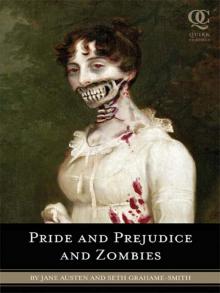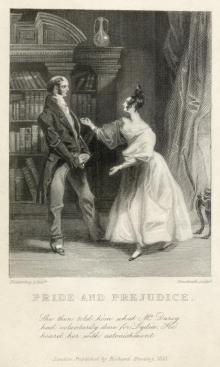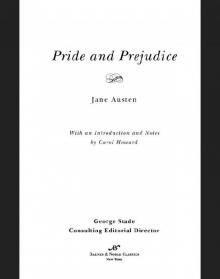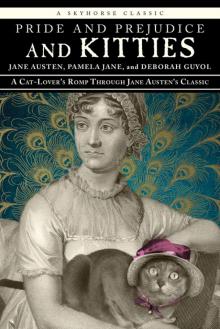- Home
- Jane Austen
Lady Susan, the Watsons, Sanditon Page 3
Lady Susan, the Watsons, Sanditon Read online
Page 3
The incident at which Emma's self-confidence appears the most attractively is the incident when she rescues Charles Blake from his sad situation at the ball. She behaves here with more feeling than decorum, and one admires her for it. The plight of a young girl left without a partner at a ball has often been described, and it is a very neat reversal of roles that enables Emma, a young girl of nineteen, at her first assembly, surrounded by strangers, to play the masculine part of rescuing a weaker spirit from distress. She does not mind being thought forward: she does not mind appearing slightly silly by dancing with a little boy: she acts at once, and with a spontaneous self-forgetfulness which is most appealing. Kindness to children and consideration for the weak, so often touchstones of good feeling, are here cleverly combined in one event. In fact, Emma has a youth, innocence and high spirits which later heroines were on the whole to lack: Fanny and Anne are in comparison rather low in energy, for different reasons, and although Emma Woodhouse is high spirited, she is also vain and self-deceiving, and encouraged to be so by her position. Emma Watson has no position: she acts freely, as herself.
Although the novel was abandoned, and although it was written in a period of some sadness, The Watsons has a vitality and optimism that one would have liked to follow to the end. The pleasures it describes are simple but real, its basic plot has a basic appeal, and even its comic characters have their virtues. Tom Musgrave may be a fashionable fool, but he is also useful in a round game: one feels he was not beyond reclamation. There is none of the slightly tired shrinking from exuberance and activity that creeps into Austen's later works: children are not tiresome, wit is not malicious, ballrooms are not yet scenes of disaster. Emma's delight in a ball is whole-hearted, like her sister's. It may be significant that Jane Austen, writing in Bath which she disliked, chose to evoke the simpler assemblies of the country: perhaps she was casting her eye back nostalgically to the life at Steventon and the assemblies at the Angel Inn at Basingstoke, from which she felt herself exiled. There is so much enjoyment in the opening chapters - the anticipation of the ball, the experience of it, and the delightful analysis of it after the event, are done with great spirit. One's frustration with The Watsons is not connected with not knowing what would happen, for even if Jane had not told Cassandra and Cassandra had not told us, we would have been able to guess. It is simply a regret that there was not more.
SANDITON
Sanditon, the last fiction that Jane Austen wrote, is quite strikingly different in some ways from her previous works. It is fairly easy to predict what The Watsons would have been like, had she finished it, but Sanditon might well have taken some unexpected new directions.
One can date its composition far more precisely than that of the other two pieces. She started it in January 1817, and dated the manuscript herself, the last date is 18 March 1817. On 18 July she died. She had been ill for at least a year, suffering from Addison's disease, a disease which was then incurable and inexplicable (though it now responds to cortisone treatment), and during the period when she wrote Sanditon, she was failing rapidly. It is not surprising, then, that the subject of health should loom rather large in Sanditon: what is perhaps surprising is the manner in which she treats it.
Three of her characters are hypochondriacs, drawn in a spirit of exaggerated comedy which seems like a return to her earlier work, after the more gentle world of Persuasion. Diana Parker, Susan Parker and Arthur Parker are all great sufferers, though for different reasons: Arthur is simply lazy, whereas his sisters are quite the reverse. They are over-energetic and over-imaginative, and having nothing real to busy themselves with (they have private incomes) they amuse themselves in 'the invention of odd complaints'. They prescribe themselves medicines, are keen on patent remedies and think nothing of having teeth pulled out in case their gums might be bad. Charlotte Heywood, the heroine, who is painted as a sensible (perhaps too sensible) young woman, thinks they would all be better if they threw their medicines out of the window or into the unnecessary fire. Charlotte is healthy, and has no nervous disorders; there is an implication that she has always been too busy and not wealthy enough to feel ill. Towards the end of the fragment, another sickly character is introduced - this time a West Indian heiress, Miss Lambe, whose guardian rejects helpful offers of asses' milk from friendly neighbours, for '"Miss Lambe was under the constant care of an experienced physician; - and his prescriptions must be their rule" - and except in favour of some tonic pills, which a cousin of her own had a property in, Mrs Griffiths did never deviate from the strict medicinal page.'
What we have here, in fact, is a dying woman treating the subject of illness with amusement and raillery. Seriously ill herself, she mocks others for their imaginary diseases. Was she trying to cheer herself up by making fun of her condition? Or was she so much in the company of physicians, and so absorbed in the subject of ill health, that the subject presented itself irresistibly? We know that her own mother, who long outlived her, was something of a hypochondriac: perhaps Sanditon was a final irony at her mother's expense. Certainly Jane Austen bore her own illness with fortitude, often pretending to feel better, careful not to occupy her mother's place on the sofa, and the writing of Sanditon appears as an act of courage.
The whole tone of the novel is very different from that of its immediate predecessor, Persuasion. Many of the characters are comic caricatures - the Parker sisters, Sir Edward and Lady Denham, for instance, are drawn in exaggerated lines, and the heroine through whose eyes we observe the action is not essentially interesting: she is something of a cipher, and when she comes to life, she is a prig. So the chief focus is not on subtle characterization and delicate relationships - it is on Sanditon itself, and the spirit of change that it represents.
From what we have of the novel, it seems probable that the greater part of the action was intended to take place in Sanditon. Willingden, on which the action briefly and violently intrudes, is hardly established, whereas Sanditon is described in much physical detail: the cliff, the village, the bay, the beach, the down, the Terrace and even the names of the houses are all distinctly placed. It is a very different place from Jane Austen's other principal locations. Her other novels are set in well-settled places - old houses, old villages, old estates. But Mr Parker has built himself a new house, and called it by a new name: he has left the old ways behind him, and launched himself busily at the future. Sanditon is a place of the future - it is not fashionable and popular like Bath, but it intends to become so.
The fact that Sanditon is a seaside resort ties in, of course, with the preoccupation with health that runs through the novel - but it would be a mistake to think that there was anything essentially new, in 1817, in the idea of a seaside holiday. Sea water cures for glandular diseases had been introduced before 1750, and bathing machines had been in use for more than half a century. Weymouth, Ramsgate, Margate, Brighton and Scarborough were already flourishing; Jane Austen herself had enjoyed trips to Dawlish, Teignmouth and Lyrne. Far from disapproving of the vogue for sea bathing, she enjoyed it herself, and wrote to Cassandra from Lyrne in September 1804 saying that 'the bathing was so delightful this morning and Molly so pressing with me to enjoy myself that I believe I staid in rather too long...' So it is not the passion for the sea itself that she is mocking in Mr Parker's enthusiasm. His faith in sea air and sea water as a universal cure is ridiculed, but Jane Austen evidently shared some of his faith and liking - otherwise she would not have given us the image of a healthy Charlotte striding happily along the beach and the downs to contrast with the fat unhealthy Arthur frowsting over his midsummer fire and toast. Perhaps she had been told once too often by ignorant neighbours that a trip to the sea would set her to rights, and one can be sure that bathing places did collect a fine crowd of hypochondriacs and quack physicians and lovers of medical gossip. But this aspect of Sanditon is not the chief target of her satire.
Her main preoccupation seems to be with speculation, expansion, change and novelty. On the whole, in her novels
and in her life she takes the side of the old ways against the new, and much of Sanditon is a brisk attack on change and its consequences. But the issue is not a simple one, and some of her evidence is on the other side. The spirit of the age was pulling her relentlessly on, and fair-minded and quick as she was, we see a little of her yearning to follow.
One's first impression, however, is of a deep and entrenched resistance. In the very first few fines, as Tony Tanner points out in his essay on Mansfield Park (Jane Austen and 'The Quiet Thing'), we have a comic contrast between the rashness of too much activity, and the good sense of staying at home. 'A couple in a carriage travelling too fast along a rough road on "Business" are "overturned". The commercial n 'Business' are 'overturned'. The commercial spirit is abroad and in its haste it has crashed! By contrast, the family that helps the shaken couple are devotees of a stable rural way of life.' We are intended to admire the rural Heywoods, with their large family and their self-satisfaction: Mr Heywood is a good landlord, he helps with his own haymaking, he doesn't like travel and can't afford newfangled ideas or possessions. Mr Parker, however, likes all that is new: he prefers canvas awnings to ancient plantations, new houses to old, new building methods to old. He does not approve of inertia, and although we are meant to be critical of his excessive enthusiasm for Sanditon, we must also notice that we are given another example of inertia in the novel. The Heywoods are not inert - they are busy about their own affairs. But Arthur Parker, the fat brother, is inert. We are told that he is too delicate to enter into a profession, a fact which his brother regrets - and later on he says, more emphatically, 'It is bad that he should be fancying himself too sickly for any profession - and sit down at one and twenty, on the interest of his own little fortune, without any idea of attempting to improve it, or of engaging in any occupation that may be of use to himself or others.' There is a strong suggestion here that even Jane Austen must believe that Arthur would be better employed expanding his fortune than doing nothing - better still that he should be of use, but failing that, better that he should improve his fortune than that he should do nothing at all. This was a new philosophy, and a new world. Hitherto, Jane Austen's characters have had incomes from land or the professions - one or two minor characters have interests in trade and banking, it is true, but attention has never been directed at these activities. Here, we see an exploration of the new spirit of growth, development and expansion. It is worth noting that her brother Henry's bank had failed in 1816 and he had been declared bankrupt - an event which had financial consequences for her own household at Chawton, and may in part account for her new and keen interest in the risks and benefits of speculation.
Mr Parker's pride in having brought blue shoes and nankin boots to Sanditon may be comic, but it is not altogether silly, and Jane Austen does not show it as reprehensible. He is shown as comic in his enthusiasms, and at times hasty and misguided, but at the same time he is kindly and responsible. He is no hardhearted property dealer; he worries about the effects of his speculation on the entire community. But, unlike Jane Austen, he is convinced that his speculation is entirely for the community's good. His building efforts will bring trade, trade will bring wealth, wealth will raise wages, and this will be a Good Thing. Jane Austen allows two characters to disagree with this point of view. One of them is Mr Heywood, who produces the view that fashionable seaside resorts are 'Bad things for a country; - sure to raise the price of provisions and make the poor good for nothing.' One accepts this view, coming from the paternal Mr Heywood, but it is not nearly so acceptable when it comes from Lady Denham. She too is old-fashioned, stands for the past, doesn't like late hours or new furniture or London hotels, but she is also exceedingly mean. She objects to wealthy West Indians because they scatter money and raise prices, and she is worried about giving her servants too much work because they will start demanding higher wages. We are in a new world when servants even start thinking of higher wages, and surely a better one. Charlotte, Mr Heywood's daughter, is thoroughly shocked by Lady Denham's meanness, and is moved to some interesting reflections on what happens to the characters of all around 'when rich people are sordid'.
So the forces of inertia, as embodied in Arthur Parker and Lady Denham, are seen as far from admirable, and some of the possibilities of change, at least, are seen as exciting. Jane Austen could hardly expect herself to embrace all the future with enthusiasm from her sick-bed, and she enjoys herself in her mockery of the Miss Beauforts' harps and telescopes, of Sir Edward's newfangled vocabulary, of Mr Parker's faith in the success of a Crescent. But she is not as firm in her support of the past as one might have supposed. The country is not ideally beautiful - the roads are appalling, and a cottage which looks 'romantic' when seen from a distance would prove to be 'as indifferent a double tenement as any in the parish' if one got a little nearer, with one old shepherd in one end of it, and three old women in the other. This does not sound like rural happiness, and even the quotation from Cowper about the simple cottager conjures up a hard struggle for subsistence as much as an image of happy poverty. Change was on the way, and perhaps Jane Austen recognizes that some at least would welcome it. The days when gentlemen like Mr Heywood could travel twice a year to London to receive their dividends were drawing to an end.
Some of the aspects of change came across in a more favourable light perhaps than she intended, but even so, a part of her heart was on the other side. Mr Parker's new house, Trafalgar House, is shown as being less comfortably situated than his old one, but his description of its virtues, exaggerated though it is, is far from unattractive. Austen may mean to mock his delight at being rocked in his bed by the grandeur of the storm, but she does not wholly succeed in doing so. One admires Mr Parker's spirit. We are all post-romantics now, and the thought of the grandeur of a storm at sea, watched from a lofty bedroom window, is irresistible. The old house might have been snug, but what is snugness compared with a sea view? Before the fashion for admiring the sea was introduced, large country houses were built a few miles from the coast, like Seaton Delaval, with no thought of orientating them towards a sea view. Who now can deny that they would have gained by one? And it does not take much historical sense to realize that the buildings which Mr Parker and his like were erecting, far from being jerry-built bungalows or drab boarding houses, were some of the most elegant that this country ever produced.
Even Charlotte, prim and uninteresting girl that she is for most of the novel, cannot resist the sea. The description of her first approach to Sanditon from inland is masterly. The little party passes first the old house in the gutter, then the church and village, with its fishermen's cottages, then a glimpse of an old farm and of Sanditon House, and then the wooded hill, with the down on top where the new buildings are - 'A little higher up, the modern began'. Charlotte takes all this in with 'the calmness of amused curiosity', and listens in the same spirit to Mr Parker's explanations of why there are so few people about - 'The tide must be flowing - about half-tide now. - He longed to be on the sands, the cliffs, at his own house, and everywhere out of his house at once. His spirits rose with the very sight of the sea...' And so do ours. Whatever the merits of secluded snugness, the flowing tide cannot be resisted: Charlotte tries to remain detached, but at the end of the chapter we find her standing 'at her ample Venetian window, and looking over the miscellaneous foreground of unfinished buildings, waving linen, and tops of houses, to the sea, dancing and sparkling in sunshine and freshness' - and whatever Jane Austen's intention, we feel that Charlotte is breathing a freer air, that she is looking out on adventure and romance. Nobody could succeed in using the sea itself as a symbol of false modernity and show. Jane Austen may mock Sir Edward's lyrical effusions on the theme, but the theme itself is too powerful for mockery.
She did not herself dislike the new romantic writers, any more than she disliked the Gothic novel which she satirizes in Northanger Abbey. She enjoyed Scott, as a poet and a novelist. She had herself a strong feeling for landscape, though when he
r heroines enthuse over it, as Fanny Price does in Mansfield Park, they tend to get laughed at by her heroes. Though she may be an enthusiast herself, she cannot strike the right note in her prose, and she recognizes this. She leaves lyricism, wisely, to others, and contents herself with parodying their excesses, an easier role. Her return to comic exaggeration in this novel, after the gentler and deeper mood of Persuasion, may well have been a reaction against the growing tide of nineteenth-century romanticism. Yet one must note that Clara, the poor but beautiful heroine in distress, and the ailing half mulatto heiress, Miss Lambe, could have stepped out of a novel by Charlotte Bronte. Austen, in Sanditon, is between two worlds, and an unknown future beckons twenty-two-year-old Charlotte Heywood.
It is a measure of the oddity of Sanditon that one cannot predict with any certainty the ways in which the plot would have developed. Was Charlotte, as seems likely, to marry the ironic, witty Sidney Parker, who one hopes would have had all the Parker family's energy without its folly? He would have provided a suitable foil for her rather negative virtues. What was to happen to the mysterious Clara Brereton - would she fall and be carried off to Timbuctoo, or would she marry? And who would get the chilly Miss Lambe? And, most important of all, how would the season in Sanditon succeed, and would the library's subscription list grow long enough to satisfy Mr Parker? Or would he, like Henry Austen, have found himself in deep financial trouble? One cannot answer any of these questions with confidence, except, perhaps, the first. The story of The Watsons would have unrolled according to its archetypal plan, but the story of Sanditon has many new and random elements, many touches of modernity for which there is no pattern. It is not as enjoyable as The Watsons, partly because it is not as secure in its attitudes, but it would have been at the least highly interesting to see how Jane Austen continued her speculations about a new, speculative, productive consumer society, so foreign to the society she had been reared in. Charlotte Heywood, hesitating in front of a tray of trinkets and trying to prevent herself from buying things she does not want, is hesitating on the brink of enormous change. One would like to know what she chose.

 Sense and Sensibility
Sense and Sensibility Persuasion
Persuasion Mansfield Park
Mansfield Park Northanger Abbey
Northanger Abbey Pride and Prejudice and Zombies
Pride and Prejudice and Zombies Pride and Prejudice
Pride and Prejudice Emma
Emma Persuasion (Dover Thrift Editions)
Persuasion (Dover Thrift Editions) Lady Susan
Lady Susan Northanger Abbey (Barnes & Noble Classics)
Northanger Abbey (Barnes & Noble Classics) Lady Susan, the Watsons, Sanditon
Lady Susan, the Watsons, Sanditon Darcy Swipes Left
Darcy Swipes Left Persuasion: Jane Austen (The Complete Works)
Persuasion: Jane Austen (The Complete Works) Mansfield Park (Barnes & Noble Classics Series)
Mansfield Park (Barnes & Noble Classics Series) Sense and Sensibility (Barnes & Noble Classics Series)
Sense and Sensibility (Barnes & Noble Classics Series) The Annotated Sense and Sensibility
The Annotated Sense and Sensibility Pride and Prejudice (Clandestine Classics)
Pride and Prejudice (Clandestine Classics) Persuasion (AmazonClassics Edition)
Persuasion (AmazonClassics Edition) Persuasion (Barnes & Noble Classics Series)
Persuasion (Barnes & Noble Classics Series) Complete Works of Jane Austen
Complete Works of Jane Austen The Watsons and Emma Watson
The Watsons and Emma Watson Northanger Abbey and Angels and Dragons
Northanger Abbey and Angels and Dragons Love and Friendship and Other Early Works
Love and Friendship and Other Early Works Emma (Barnes & Noble Classics Series)
Emma (Barnes & Noble Classics Series) Sanditon
Sanditon Pride and Prejudice (Barnes & Noble Classics Series)
Pride and Prejudice (Barnes & Noble Classics Series) Pride and Prejudice and Kitties
Pride and Prejudice and Kitties The Annotated Northanger Abbey
The Annotated Northanger Abbey Oxford World’s Classics
Oxford World’s Classics Northanger Abbey (Barnes & Noble Classics Series)
Northanger Abbey (Barnes & Noble Classics Series) The Annotated Persuasion
The Annotated Persuasion Emma (AmazonClassics Edition)
Emma (AmazonClassics Edition) The Annotated Emma
The Annotated Emma The Annotated Mansfield Park
The Annotated Mansfield Park The Annotated Pride and Prejudice
The Annotated Pride and Prejudice